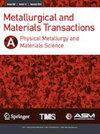严格评价定向凝固过程中二次晶粒形成机制的结晶学基础
IF 2.5
3区 材料科学
Q3 MATERIALS SCIENCE, MULTIDISCIPLINARY
Metallurgical and Materials Transactions A-Physical Metallurgy and Materials Science
Pub Date : 2023-09-13
DOI:10.1007/s11661-023-07194-7
引用次数: 0
摘要
摘要提出了一种基于结晶学的方法,用于对定向凝固过程中引发二次晶粒形成的可能机制进行批判性评价。该方法允许对大量缺陷进行分析,同时避免了受枝晶立体学影响的金相切片方法的陷阱。本文对单晶涡轮叶片常用的镍基高温合金CMSX-4进行了研究。所有次生晶粒完全起源于外表面,当测量离轴原生$$\langle 0\,0\,1\rangle$$⟨0 0 1⟩晶体方向时,在单晶原生枝晶的会聚和发散配置中都是明显的,没有明显的偏差。几乎所有的次级晶粒都有低的取向偏差,平均取向偏差在5到15度之间。观察到次级晶粒和单晶的个别$$\langle 0\,0\,1\rangle$$⟨0 0 1⟩取向之间没有系统偏差。当主臂会聚于外表面时,在距其中一个副臂30度以内的轴上发生显著的扭转贡献,但在发散情况下,扭转和倾斜都占主导地位。成核和浮力驱动的热溶质对流都可以作为潜在的机制消除。热-机械变形被推断为最可能的机制;变形必须起源于初生枝晶尖端附近。有人提出,在主要的垂直热梯度存在的情况下,轴向收缩时,枝晶偏转主要是由于初级尖端与外表面所遇到的阻力引起的。本文章由计算机程序翻译,如有差异,请以英文原文为准。
A Crystallographic Basis for Critically Evaluating the Mechanisms for Secondary Grain Formation During Directional Solidification
Abstract A crystallography-based method is presented for the critical appraisal of possible mechanisms that trigger the formation of secondary grains during directional solidification. The method permits an analysis of a large population of defects, while avoiding the pitfalls of the metallographic sectioning approach that is affected by dendrite stereology. Here, the nickel-base superalloy CMSX-4, an alloy commonly used for single crystal turbine blade applications, is studied. All secondary grains originate exclusively at the external surface and when the off-axial primary $$\langle 0\,0\,1\rangle$$ ⟨ 0 0 1 ⟩ crystal orientations are measured, are evident at both the converging and diverging dispositions of the single crystal primary dendrites without a noticeable bias. Almost all of the secondary grains have low misorientations, with an average misorientation between 5 to 15 deg. No systematic deviation between the individual $$\langle 0\,0\,1\rangle$$ ⟨ 0 0 1 ⟩ orientations of the secondary grain and the single crystal is observed. A significant twist contribution about an axis within ~ 30 deg from one of the secondary arms occurs when primary arms converge on the external surface, but both twist and tilt prevail for the diverging case. Both nucleation and buoyancy driven thermo-solutal convection can be eliminated as potential mechanisms. Thermo-mechanical deformation is deduced to be the most likely mechanism; deformation must originate in the vicinity of the primary dendrite tips. It is proposed that dendrite deflection arises primarily from the resistance encountered by the primary tips with the external surface during axial contraction in the presence of a dominant vertical thermal gradient.
求助全文
通过发布文献求助,成功后即可免费获取论文全文。
去求助
来源期刊
CiteScore
5.30
自引率
7.10%
发文量
322
审稿时长
6 months
期刊介绍:
Metallurgical and Materials Transactions A focuses on the latest research in all aspects of physical metallurgy and materials science. It explores relationships among processing, structure, and properties of materials; publishes critically reviewed, original research of archival significance.
The journal address the main topics of alloy phases; transformations; transport phenomena; mechanical behavior; physical chemistry; environment; welding & joining; surface treatment; electronic, magnetic & optical material; solidification; materials processing; composite materials; biomaterials; and light metals. MMTA publishes Technical Publications, Communications, Symposia, and more.
Published with ASM International, The Materials Information Society and The Minerals, Metals & Materials Society (TMS)

 求助内容:
求助内容: 应助结果提醒方式:
应助结果提醒方式:


